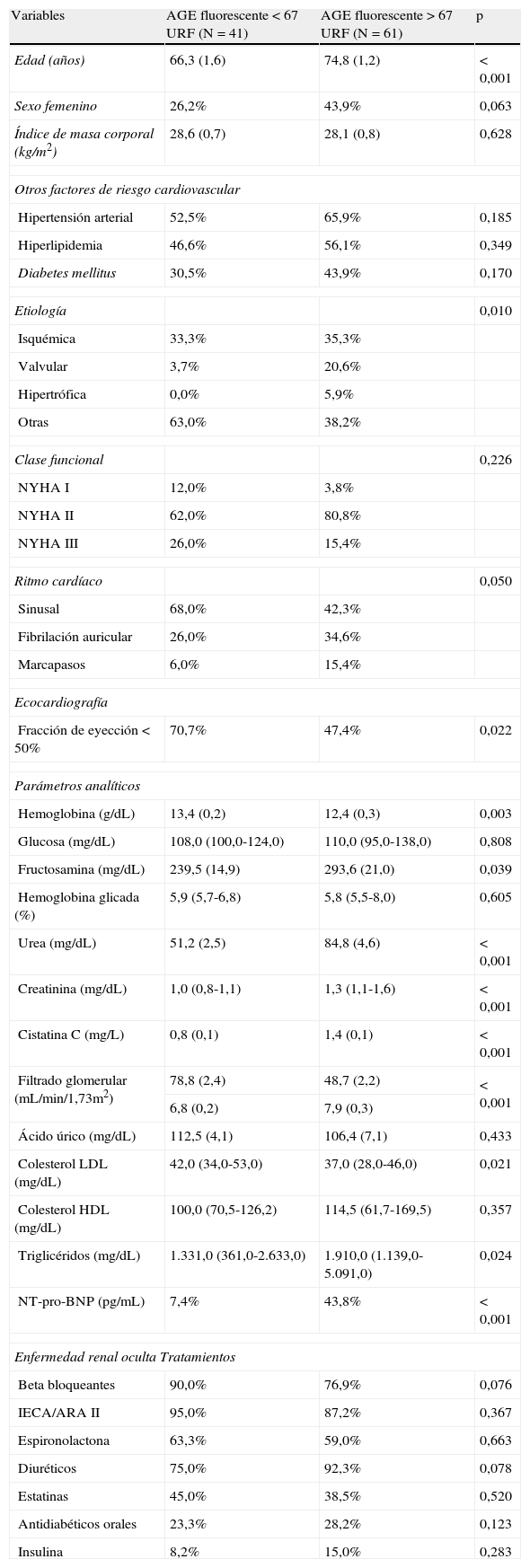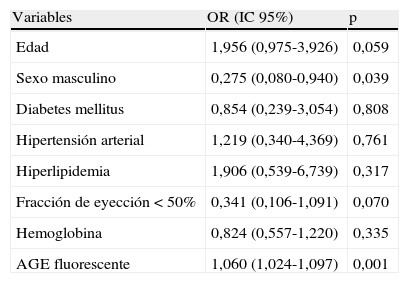Los productos finales de glicación avanzada (AGE) están involucrados en la fisiopatología y pronóstico de la insuficiencia cardíaca (IC), acumulándose en situaciones como la insuficiencia renal (IR). El objetivo del estudio fue analizar la relación de AGE e IR en pacientes con IC crónica.
Material y métodoSe incluyeron un total de 102 pacientes de forma consecutiva procedentes de la consulta de IC. Se obtuvieron datos clínicos y analíticos, con medición de hemoglobina glicada, péptido natriurético cerebral, cistatina C y AGE fluorescente, estimándose de cada paciente la tasa de filtración glomerular (TFG).
ResultadosEl 40,2% de los pacientes presentaron una TFG < 60ml/min/1,73m2 y el 11,7% enfermedad renal oculta. Los AGE presentaron una clara correlación positiva con la creatinina (r=0,685, p<0,001) y la cistatina C (r=0,682, p<0,001) y negativa con la TFG (r=−0,720, p<0,001). La media de AGE fluorescentes en pacientes con IR fue mayor que en aquellos sin IR (media [DE] de 83,4 [3,3] URF frente a 56,8 [2,1] URF, p<0,001). En cuanto a su valor para el diagnóstico de enfermedad renal oculta, los AGE fluorescentes presentaron un área bajo la curva ROC superior a la de otros parámetros de IR, como la cistatina C. El análisis multivariado demostró que los AGE fluorescentes son un marcador independiente de IR (odds ratio [OR] 1,06; intervalo de confianza del 95% [IC 95%] 1,024-1,097; p=0,001).
ConclusionesLos AGE actúan como un marcador de IR en pacientes con IC crónica, tanto diabéticos como no diabéticos, siendo superiores a la cistatina C en la detección de enfermedad renal oculta.
Advanced glycation end-products (AGE) are implicated in the physiopathology and prognosis of heart failure (HF) and they accumulate in situations such as kidney failure (KF). Our objective was to analyze the relation between AGE and KF in patients with chronic HF.
Materials and methods102 consecutive patients of our medical center were included. Clinical and analytical data were obtained, with measurement of glycated haemoglobin, brain natriuretic peptide, cystatin C and fluorescent AGE. Glomerular filtration rate (GFR) was estimated for each patient.
Results40.2% of patients presented GFR < 60mL/min/1.73m2 and 11.7% had hidden kidney disease (HKD). AGE correlated positively with creatinine (r=0.685, p<0.001) and cystatin C (r=0.682, p<0.001) and negatively with GFR (r=−0.720, p<0.001). Medium value of fluorescent AGE in patients with KF was higher than those without KF (83.4 [3.3] URF vs 56.8 [2.1] URF, p<0.001). With regard to the diagnostic value for HKD, fluorescent AGE presented an area under the ROC curve higher than other parameters for KD such as cystatin C. In the multivariate analysis, fluorescent AGE were an independent biomarker of KD (OR 1.060; 95% CI 1.024-1.097; p=0.001).
ConclusionsAGE act as a biomarker of KD in patients with chronic HF, both diabetics and non diabetics, being better than cystatin C in the detection of HKD.
Artículo
Comprando el artículo el PDF del mismo podrá ser descargado
Precio 19,34 €
Comprar ahora














